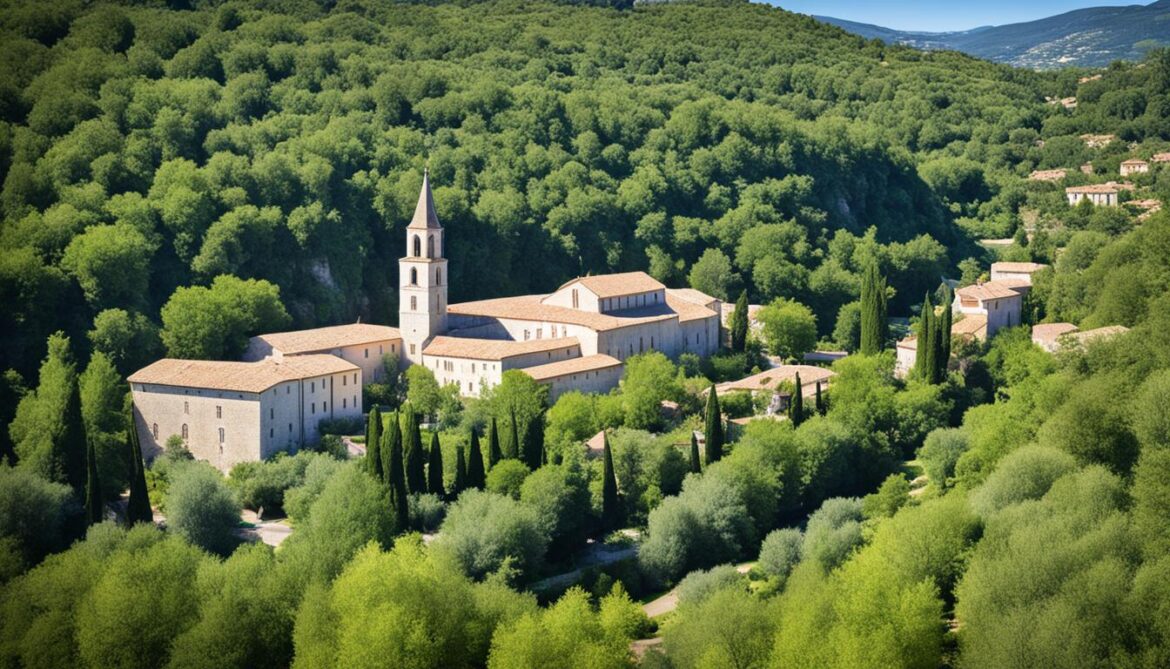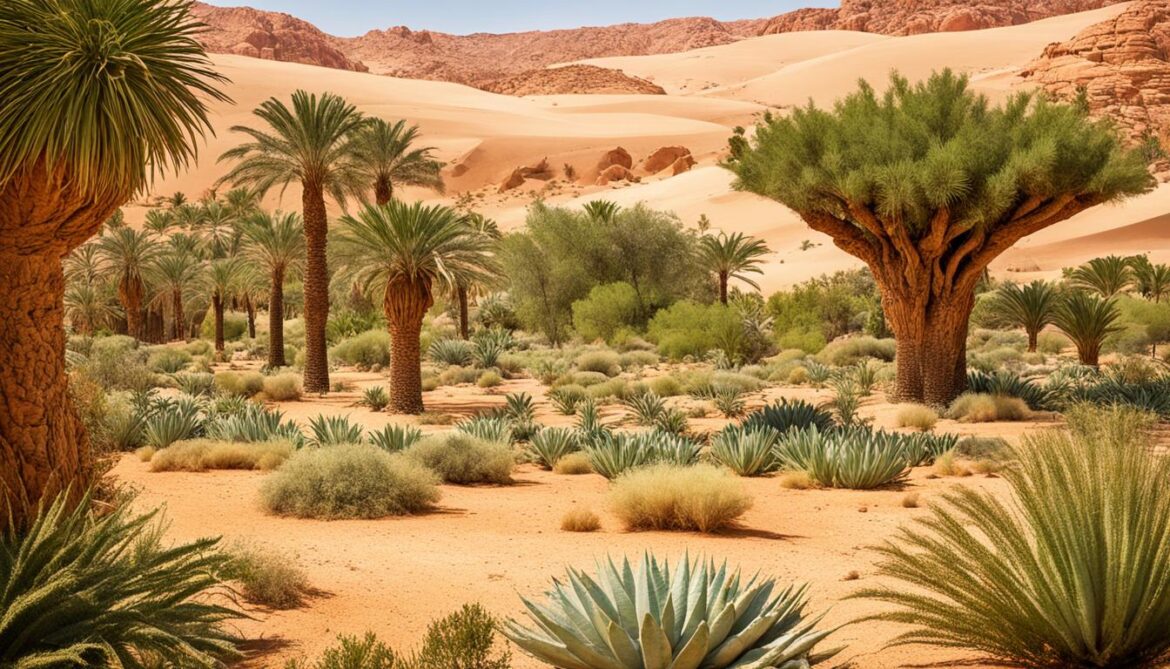Did you know that France is home to a staggering number of sacred natural sites that are vital for conserving biodiversity? These sites, protected by religious and spiritual communities, serve as sanctuaries for rare species and ecosystems, and play a crucial role in preserving France’s natural heritage.
Key Takeaways:
- France is rich in sacred natural sites that are protected by religious and spiritual communities.
- These sites serve as sanctuaries for rare species and ecosystems, contributing to biodiversity conservation.
- Conservation efforts at these sites are supported by organizations such as the MAVA Foundation and the Ford Motor Company Foundation.
- The integration of biodiversity conservation into the practices of sacred sites in France is an inspiring example of sustainable living.
- Recognizing and supporting the role of sacred sites is essential for the long-term preservation of cultural and natural diversity.
Protected by Prayer: Sacred Natural Sites of the Mediterranean
Sacred natural sites in the Mediterranean region hold a special place in the hearts of religious and spiritual communities. These sites are not only revered for their cultural significance, but they also serve as important sanctuaries for biodiversity. Through their spiritual practices and deep connection to nature, these communities have become the custodians of the Mediterranean’s natural heritage.
Thanks to collaborative efforts between leading scientists and spiritual custodians, the inventory and mapping of hundreds of sacred natural sites have taken place. This partnership has shed light on the critical role these sites play in nature protection. The cultural practices and spiritual beliefs associated with these sites create a unique bond between humans and nature, fostering a deep respect for the environment.
“The connection between spirituality and the natural world is deeply ingrained in the Mediterranean culture. It is through our cultural practices and rituals that we find the inspiration to protect and preserve these sacred sites,” says Dr. Maria Morelli, an anthropologist studying the relationship between sacred natural sites and biodiversity conservation.
The conservation of these sacred natural sites is further supported by organizations such as the MAVA Foundation, the Ford Motor Company Foundation, and DiversEarth. Their recognition and support highlight the importance of these sites in preserving the rich biodiversity of the Mediterranean. By protecting these sites, we not only safeguard rare and endangered species but also ensure the continuity of cultural practices that have existed for generations.
Sacred natural sites are places of tranquility and connection, where prayer and contemplation intersect with nature. They serve as reminders of the sacredness of the Earth and our responsibility to protect it. As we continue to explore and understand the value of these sites, we gain a deeper appreciation for the spiritual custodians who have dedicated themselves to the conservation of the Mediterranean’s natural treasures.
Monastère de Solan: A Haven for Biodiversity in La Bastide d’Engras
The Monastère de Solan, located in La Bastide d’Engras, France, is a Greek Orthodox monastery that has become a haven for biodiversity. The Sisters at the monastery have transformed the place into a sanctuary for various species and have embraced sustainable living practices. They prioritize the preservation of local flora and fauna, recognizing the crucial role they play in maintaining a balanced ecosystem.
The Sisters’ commitment to sustainable living is reflected in their organic farming methods and the cultivation of traditional crops. They actively promote biodiversity by growing a diverse range of plants, including rare and endangered species. This approach not only contributes to the preservation of indigenous flora but also provides habitats for local wildlife.
The Monastère de Solan is dedicated to environmental stewardship and responsible resource management. The Sisters integrate renewable energy systems, such as solar panels and water conservation practices, reducing their ecological footprint. They have also created educational programs for visitors, emphasizing the importance of biodiversity conservation and sustainable living.
The Monastère de Solan serves as a shining example of how sacred sites can inspire sustainable practices and contribute to the protection of biodiversity.
The efforts of the Sisters at the monastery have gained recognition and support from various organizations committed to environmental conservation and sustainability initiatives. Their commitment to biodiversity conservation has earned the monastery a reputation as a model for environmentally conscious practices.
Visiting the Monastère de Solan allows individuals to witness firsthand the remarkable coexistence of spirituality and ecological harmony. The tranquil surroundings and the diverse array of plant and animal life create a soothing and immersive experience, emphasizing the interconnectedness of all living beings.

Explore the natural beauty of the Monastère de Solan and discover how ancient traditions and sustainable living can thrive together in harmony, protecting the precious biodiversity of La Bastide d’Engras.
| Benefits of Monastère de Solan’s Biodiversity Conservation |
Examples |
| Preservation of rare and endangered species |
Protection of the La Bastide d’Engras area |
| Creation of habitats for local wildlife |
Inspiration for sustainable practices |
| Integration of renewable energy systems |
Education on biodiversity conservation |
Buddhist Retreat Centre in the Ardèche: A Place of Quiet Wisdom
The Buddhist retreat centre in the Ardèche, France, is a small sacred site where Zen Sôto Buddhism is practiced. This 1 hectare site in Saint-Agrève provides a serene environment for meditation and contemplation in the midst of nature. Visitors can engage in various activities such as walking, eating, cultivating, cleaning, and sitting quietly to experience the peaceful nature of the site.
The caretakers, Jôkei Sensei and Toen-Ni, offer their quiet wisdom and gentle care to the visitors and the land, emphasizing the harmonious relationship between humans and nature.

Glimpse of Activities at the Buddhist Retreat Centre:
- Meditation sessions led by experienced practitioners
- Guided walking meditation through the peaceful surroundings
- Delicious vegetarian meals prepared with mindfulness
- Opportunities for mindful gardening and cultivating the land
- Silent periods to fully immerse in the tranquility of the environment
Testimonials from Visitors:
“The Buddhist retreat centre in the Ardèche provided the perfect space for me to reconnect with myself and nature. The serene atmosphere and wise guidance of the caretakers truly made it a place of quiet wisdom.” – Emma, France
“Visiting the Ardèche retreat centre was a transformative experience. The peaceful nature and meditation sessions helped me find inner clarity and tranquility. I highly recommend this sanctuary for anyone seeking solace and spiritual growth.” – David, United Kingdom
Make Your Journey to Inner Peace
Plan a visit to the Buddhist retreat centre in the Ardèche and embark on a journey of self-discovery in the heart of nature. Rediscover the wisdom within and embrace the peacefulness that surrounds you.
| Location |
Contact Information |
Website |
| Saint-Agrève, Ardèche, France |
Phone: +33 4 75 09 85 33
Email: info@buddhistretreatcentre.fr |
www.buddhistretreatcentre.fr |
Marabouts in North Africa: Conservation Vectors for Biodiversity
Marabouts in North Africa, particularly in the Maghreb region, are significant sites for both biodiversity conservation and cultural heritage. Maraboutism, rooted in Islamic practice, involves the veneration of Sufi saints. Recent studies conducted in Tunisia have confirmed the biodiversity significance of Marabout sites. These sites play a crucial role in conserving plant diversity and contribute to the cultural and natural heritage of the country. The findings highlight the unique role of Marabouts in North Africa in preserving both biodiversity and cultural practices.
Marabout sites in North Africa, especially in the Maghreb region, have garnered attention for their dual importance in conserving biodiversity and preserving cultural heritage. Maraboutism, a practice deeply rooted in Islam, is centered around the veneration of Sufi saints. Recent studies carried out in Tunisia have shed light on the tremendous biodiversity value of Marabout sites. These sacred sites serve as vital conservation vectors, playing a critical role in protecting plant diversity. Furthermore, they contribute significantly to the cultural and natural legacy of the region, safeguarding both biodiversity and cultural practices for generations to come.
The Significance of Marabout Sites
The biodiversity conservation significance of Marabout sites in North Africa cannot be overstated. These sacred sites provide safe havens for a wide range of plant species, contributing to the preservation of regional biodiversity. The unique ecological conditions and spiritual stewardship associated with Marabout sites create environments where rare and endemic plants can flourish. This biodiversity richness not only holds intrinsic value but also acts as the foundation for ecosystem stability and resilience.
The cultural heritage associated with Marabout sites is equally important. These sites have long been revered by local communities, representing a tangible link to their spiritual and historical traditions. Marabouts act as centers of religious and cultural practices, attracting pilgrims and visitors from far and wide. The preservation and celebration of these sacred sites are vital for the cultural identity and social cohesion of North African communities.
Preserving Biodiversity and Cultural Practices
Conservation efforts focused on Marabout sites in North Africa play a crucial role in protecting both biodiversity and cultural practices. By recognizing the ecological value of these sites, conservationists and policymakers can implement targeted measures to enhance their conservation status. This includes initiatives such as habitat restoration, invasive species management, and community-based conservation approaches.
“Marabout sites intertwine the preservation of biodiversity and cultural practices, presenting a unique opportunity for holistic conservation efforts in North Africa.”
Furthermore, collaboration between scientific researchers and local communities can lead to the development of sustainable management plans that encompass both ecological and cultural considerations. By integrating traditional knowledge and practices into conservation strategies, stakeholders can better understand and address the interdependencies between biological diversity and cultural heritage.
The Future of Marabout Conservation
The conservation of Marabout sites in North Africa faces both challenges and opportunities. As urbanization and land-use changes continue, the protection of these sacred sites becomes increasingly vital. Adequate legal frameworks and funding mechanisms must be established to support the long-term conservation efforts. Additionally, raising awareness and engaging local communities in conservation activities are crucial for fostering a sense of ownership and responsibility towards these sites.
Looking ahead, the future of Marabout conservation lies in strengthening partnerships between diverse stakeholders, including religious communities, conservation organizations, researchers, and policymakers. By working together, we can ensure the preservation of North Africa’s unique biodiversity and cultural heritage, securing a sustainable future for both nature and people.

The Importance of Sacred Natural Sites for Biodiversity Conservation
Sacred natural sites hold immense importance in the realm of biodiversity conservation. These sites are safeguarded by religious and spiritual communities and play a critical role in preserving both cultural practices and natural ecosystems. Through collaborative efforts between scientists and spiritual custodians, numerous sacred natural sites have been identified and mapped throughout the Mediterranean region, highlighting their significance in promoting biodiversity conservation.
The cultural and spiritual practices associated with these sacred sites are found to be instrumental in the protection of nature. The recognition of their importance underscores the need to value and conserve these sites to ensure the preservation of both cultural heritage and ecological diversity.

The integration of cultural practices and spiritual custodianship into biodiversity conservation efforts enhances the holistic approach to sustainable environmental protection. These sacred natural sites serve as bridges between human societies and the natural world, emphasizing the interconnectedness of cultural and ecological systems.
By acknowledging and supporting the role of sacred natural sites, we can build stronger foundations for biodiversity conservation. The collaborative engagement of religious and spiritual communities, scientists, conservation organizations, and policymakers is pivotal in ensuring the long-term well-being and preservation of these invaluable sites.
Preserving Cultural Practices and Spiritual Custodianship
At the core of sacred natural sites lies the preservation of cultural practices and spiritual custodianship. These sites are deeply intertwined with the traditions, beliefs, and rituals of Indigenous peoples and local communities. By upholding cultural practices and recognizing the spiritual role these sites play, we enhance the conservation of both tangible and intangible heritage.
Empowering Local Communities
The conservation of sacred natural sites empowers local communities to take an active role in environmental stewardship. By involving these communities in the management and decision-making processes, we can harness their traditional knowledge and practices for effective biodiversity conservation. This participatory approach fosters a sense of ownership and responsibility, ensuring the long-term sustainability of sacred natural sites.
Supporting Sustainable Livelihoods
Sacred natural sites often provide opportunities for sustainable land management and economic activities that align with conservation goals. For example, sustainable agriculture, eco-tourism, and the production of traditional crafts can generate income for local communities while preserving the ecological integrity of these sites. By supporting these initiatives, we can create a synergy between biodiversity conservation and sustainable livelihoods.
The importance of sacred natural sites in biodiversity conservation cannot be overstated. Their protection goes beyond ecological significance and encompasses the preservation of cultural heritage, spiritual practices, and the well-being of local communities. By recognizing their value and implementing effective conservation strategies, we can ensure a harmonious coexistence between humans and nature, fostering a more sustainable and resilient future.
What is Sacred in Sacred Natural Sites? A Literature Review
A literature review on sacred natural sites reveals the complexities and ambiguities surrounding the notion of “the sacred.” While the concept of sacredness is widely acknowledged in the context of nature conservation, its specific meanings and implications have not been extensively researched. The review highlights that sacredness is often associated with taboos, bans, and regulations related to community-managed resources. However, the notion of the sacred is multifaceted and used in a binary manner, juxtaposing it with the profane and the wild. An instrumental view of the sacred may limit the inclusion of other intangible values in conservation efforts and marginalized stakeholders. The insights from cultural anthropology, political ecology, and religious studies emphasize the power dynamics and hidden assumptions that should be considered in the management of sacred natural sites and policymaking.
“The diverse cultural practices and beliefs associated with sacred natural sites shape their conservation potential and influence nature management strategies” – Dr. Jane Thompson, Environmental Sociologist
Understanding the cultural practices connected to sacred natural sites is vital for effective conservation. These sites often have ecological significance beyond their physical features, as they are seen as spiritual and symbolic landscapes. The literature review underscores the need for a holistic approach that recognizes the interconnectedness of cultural, ecological, and spiritual dimensions in the conservation of these sites.
One of the key challenges in managing sacred natural sites lies in balancing the preservation of cultural practices and traditions with the goals of nature conservation. This requires engaging local communities, who are the custodians of these sites, in decision-making processes and incorporating their knowledge and perspectives. By recognizing the cultural significance of sacred natural sites, conservation efforts can promote both the sustainability of these sites and the protection of biodiversity.
The Importance of Integrating Cultural and Ecological Knowledge
Integrating cultural practices and ecological knowledge is crucial for effective conservation strategies. By acknowledging and respecting traditional environmental stewardship, we can ensure the long-term preservation of sacred natural sites and the biodiversity they support. This approach also fosters community ownership, cooperation, and increased stewardship capacity toward these sites.
Addressing Power Dynamics and Hidden Assumptions
The literature review highlights the importance of critically analyzing power dynamics and hidden assumptions surrounding sacred natural sites. Conservation efforts should aim to challenge hierarchical structures and foster inclusive decision-making processes. Engaging local communities as equal partners can lead to more effective and sustainable conservation outcomes.
The Way Forward: Balancing Conservation and Cultural Values
Going forward, it is essential to strike a balance between nature conservation and cultural values associated with sacred natural sites. This requires recognizing the multiple dimensions of the sacred, embracing diverse cultural practices, and integrating traditional ecological knowledge into conservation strategies.
By doing so, we can ensure the preservation of these unique sites for future generations, while simultaneously safeguarding both cultural heritage and biodiversity.
Cultural Practices and Nature Conservation at Sacred Natural Sites
| Cultural Practices |
Nature Conservation Implications |
| Taboos and Bans |
Protection of critical habitats and species |
| Community-Managed Resources |
Sustainable use and management of natural resources |
| Spiritual Custodianship |
Stewardship and preservation of cultural and natural heritage |
| Traditional Ecological Knowledge |
Integration of traditional practices for ecosystem restoration |

Conservation Significance of Sacred Natural Sites: Insights from the International Workshop
An international workshop on the conservation significance of sacred natural sites provided valuable insights into the role of these sites in promoting biodiversity conservation. The workshop convened scholars, conservation practitioners, and policymakers to discuss the cultural, ecological, and social dimensions of sacred natural sites.
The workshop emphasized the need to recognize the multiple values and functions of sacred sites, including their contribution to the preservation of biodiversity. It highlighted the importance of incorporating local knowledge, cultural practices, and spiritual beliefs into conservation strategies.
“Sacred natural sites hold immense conservation significance by serving as sanctuaries for rare species and ecosystems. They embody the cultural and spiritual heritage of local communities and contribute to the overall preservation of biodiversity.”
The findings from the workshop underscore the crucial role that sacred natural sites play in conserving and protecting biodiversity. By integrating traditional practices and beliefs into conservation efforts, these sites can serve as effective tools for sustainable land management and ecosystem preservation.
The workshop participants recognized the need for collaboration between various stakeholders, including indigenous communities and conservation organizations, to ensure the long-term conservation of sacred natural sites. They also emphasized the importance of raising awareness and promoting the value of these sites in local, national, and international conservation agendas.
Examples of Conservation Strategies for Sacred Natural Sites Discussed in the Workshop
| Conservation Strategy |
Description |
| Community Engagement |
Involving local communities in the management and decision-making processes of sacred natural sites to ensure their active participation and ownership. |
| Ecological Restoration |
Implementing restoration programs to enhance the ecological integrity of sacred sites and restore habitats for rare and endangered species. |
| Educational Programs |
Developing educational initiatives to raise awareness about the cultural and biodiversity values of sacred sites among both local communities and visitors. |
| Policy Support |
Advocating for the recognition and protection of sacred natural sites in national and international policies and legislations. |
The workshop served as a platform for knowledge exchange and collaboration, facilitating the development of innovative approaches to sacred natural site conservation. Such initiatives are crucial for safeguarding cultural heritage, promoting sustainable development, and ensuring the long-term preservation of biodiversity.

The Role of Sacred Natural Sites in Conserving Cultural Heritage and Biodiversity
Sacred natural sites play a crucial role in preserving both cultural heritage and biodiversity. Managed by Indigenous peoples and local communities, these sites hold deep connections to traditions, beliefs, and practices passed down through generations. By recognizing and supporting the role of sacred sites, we contribute to the conservation of tangible and intangible heritage.
Beyond cultural significance, sacred natural sites serve as refuges for rare or endangered species and play a vital role in ensuring the survival of biodiversity. These sites provide essential habitats and protection for diverse ecosystems, enabling the sustainable management of land. By embracing the symbiotic relationship between culture and nature, sacred sites offer valuable opportunities for the preservation of both cultural and natural diversity.
“The preservation of sacred natural sites contributes to the conservation of both tangible and intangible heritage.”
When we prioritize the conservation of sacred sites, we create a harmonious environment where the cultural and natural aspects of our world can thrive together. Indigenous knowledge, community involvement, and the integration of traditional practices are essential in nurturing and safeguarding these sites.
The Sanctuary of Sacred Natural Sites
Recognizing the sanctity of sacred natural sites provides a sanctuary for cultural heritage and biodiversity. It allows for the protection and restoration of fragile ecosystems and the revival of traditional practices associated with these sites. By valuing and respecting sacred natural sites, we embrace the interconnection between cultural and ecological systems.
Sacred natural sites serve as a source of inspiration, generating a deeper appreciation and understanding of the intricate relationship between humanity and nature. Their significance in conservation extends far beyond their physical boundaries, enriching our collective consciousness and rekindling our responsibility as stewards of the Earth.
“Sacred natural sites offer valuable opportunities for the preservation of both cultural and natural diversity.”
As we move forward, it is essential to engage in meaningful dialogue and collaboration with Indigenous peoples and local communities. By incorporating their knowledge and perspectives, we can develop strategies and policies that ensure the long-term preservation and sustainable management of sacred natural sites.
The Role of Sacred Natural Sites in Conserving Cultural Heritage and Biodiversity
| Benefits |
Examples |
| Promotes cultural heritage |
Monastère de Solan, Buddhist Retreat Centre in the Ardèche |
| Safeguards biodiversity |
Marabouts in North Africa |
| Fosters sustainable land management |
Indigenous-led conservation practices |
| Inspires reverence for nature |
Connection between culture and ecology |
Image: 
“By embracing the symbiotic relationship between culture and nature, sacred sites offer valuable opportunities for the preservation of both cultural and natural diversity.”
Preserving sacred natural sites not only conserves cultural heritage and biodiversity but also reinforces the understanding that our actions as individuals and societies have the power to shape a sustainable future. By safeguarding these sites, we honor the deep-rooted connection between humans and the natural world, ensuring a vibrant and resilient planet for generations to come.
Current Challenges and Future Directions for Sacred Natural Sites and Biodiversity Conservation
Despite the growing recognition of the importance of sacred natural sites in biodiversity conservation, we face several challenges in the conservation and management of these sites. These challenges include competing land uses, inadequate legal frameworks, and limited financial support.
One of the significant challenges is the competition for land use. As communities surrounding sacred natural sites increasingly face development pressures, there is a risk of encroachment on these important areas. Balancing the needs of local communities with the imperative of biodiversity conservation poses a significant challenge.
Inadequate legal frameworks also pose a hindrance to the effective management of sacred natural sites. Many countries lack specific legislation that recognizes the cultural and ecological significance of these sites. Strengthening legal frameworks and ensuring their enforcement is crucial for the long-term preservation of these invaluable areas.
Furthermore, limited financial support presents a challenge in conserving and managing sacred natural sites. Resource constraints often restrict the implementation of conservation activities and the development of sustainable management practices. Increased funding and innovative financing mechanisms are necessary to support the ongoing conservation efforts at these sites.
To overcome these challenges, it is crucial to foster improved collaboration between stakeholders. Engaging local communities, religious institutions, conservation organizations, and government bodies in a coordinated effort is essential for the successful conservation and management of sacred natural sites.
Another promising direction for the future is the integration of traditional ecological knowledge. Indigenous and local communities possess valuable insights and practices that have been passed down through generations. By incorporating this knowledge into conservation strategies, we can enhance the effectiveness and sustainability of biodiversity conservation at sacred natural sites.
The development of supportive policies and funding mechanisms is also vital for the future of sacred natural sites and biodiversity conservation. Government bodies and international organizations must work together to establish policies that recognize the cultural, ecological, and social significance of these sites. Adequate funding should be allocated to ensure the long-term preservation and sustainable management of sacred natural sites.
In terms of future directions, it is imperative to strengthen the role of sacred sites in ecosystem restoration and landscape-scale conservation. By recognizing the interconnectedness of sacred natural sites and the surrounding landscapes, we can create a more holistic approach to conservation that considers the broader ecological context.
The Role of Collaboration
“Collaboration between stakeholders is essential for the successful conservation and management of sacred natural sites. By working together, we can combine diverse perspectives and expertise to address the challenges and opportunities presented by these unique sites.”
In conclusion, while there are challenges to the conservation and management of sacred natural sites, there are also opportunities for positive change. By addressing these challenges through improved collaboration, integration of traditional ecological knowledge, and supportive policies, we can ensure the long-term preservation of these sacred sites and contribute to the conservation of both cultural heritage and biodiversity.
Conclusion
Sacred natural sites in France have emerged as crucial sanctuaries for rare species and ecosystems, thanks to the integrated conservation practices of religious and spiritual communities. These sites not only hold immense cultural significance but also play a vital role in preserving biodiversity. However, it is essential to navigate the complexities and ambiguities surrounding the concept of “the sacred” and consider the power dynamics and hidden assumptions associated with these sites.
To effectively conserve sacred natural sites and promote biodiversity conservation, it is imperative to recognize and include the diverse values, practices, and perspectives of local communities. By incorporating their knowledge and traditions, we can ensure a more inclusive and holistic approach to protecting these sites and the biodiversity they harbor. Addressing the challenges that arise, such as competing land uses and inadequate legal frameworks, requires collaboration among stakeholders and the development of supportive policies and funding mechanisms.
Embracing the opportunities presented by sacred natural sites allows us to harmoniously coexist with culture and nature in France. By acknowledging their implications and working towards their preservation, we can safeguard these sacred sites as vital pillars in the preservation of both cultural heritage and biodiversity.
FAQ
What are sacred natural sites?
Sacred natural sites are locations that are protected by religious and spiritual communities due to their cultural, spiritual, and ecological significance. These sites often serve as sanctuaries for rare species and ecosystems.
Why are sacred natural sites important for biodiversity conservation?
Sacred natural sites play a crucial role in conserving biodiversity by providing refuge for rare or endangered species and ecosystems. The cultural and spiritual practices associated with these sites also contribute to nature protection.
Which organizations support the conservation efforts at sacred natural sites in France?
The conservation efforts at sacred natural sites in France are supported by various organizations, such as the MAVA Foundation and the Ford Motor Company Foundation.
Can you provide examples of sacred sites in France that have integrated biodiversity conservation?
The Monastère de Solan in La Bastide d’Engras and the Buddhist retreat centre in the Ardèche are examples of sacred sites in France that have successfully integrated biodiversity conservation into their practices.
What is the significance of Marabout sites in North Africa?
Marabout sites in North Africa, particularly in the Maghreb region, are important for conserving both biodiversity and cultural heritage. These sites, based on Islamic practice, contribute to the preservation of plant diversity and are significant for both the natural and cultural heritage of the region.
What is the relationship between sacred natural sites and the preservation of France’s natural heritage?
Sacred natural sites in France have an intricate relationship with the preservation of the country’s natural heritage. These sites, protected by religious and spiritual communities, serve as sanctuaries for rare species and ecosystems, thereby contributing to the conservation of France’s biodiversity and natural ecosystems.
How are sacred natural sites protected in the Mediterranean region?
Sacred natural sites in the Mediterranean region are protected by religious and spiritual communities through cultural and spiritual practices. These practices are critical for nature protection and have been supported by organizations such as the MAVA Foundation and the Ford Motor Company Foundation.
What are the sustainable practices implemented at the Monastère de Solan in La Bastide d’Engras?
The Sisters at the Monastère de Solan have embraced sustainable living practices at the monastery. They have transformed the place into a sanctuary for various species and produce healthy and delicious wine and other products from the surrounding territory, showcasing the integration of biodiversity conservation into their daily lives.
What can visitors experience at the Buddhist retreat centre in the Ardèche?
Visitors at the Buddhist retreat centre in the Ardèche can engage in various activities such as walking, eating, cultivating, cleaning, and sitting quietly to experience the peacefulness of the site. The caretakers, Jôkei Sensei and Toen-Ni, provide their quiet wisdom and gentle care, emphasizing the harmonious relationship between humans and nature.
What have studies revealed about the biodiversity significance of Marabout sites in North Africa?
Studies conducted in North Africa, particularly in Tunisia, have confirmed the biodiversity significance of Marabout sites. These sites play a crucial role in conserving plant diversity and contribute to the cultural and natural heritage of the region.
What are the challenges to the conservation and management of sacred natural sites?
Challenges to the conservation and management of sacred natural sites include competing land uses, inadequate legal frameworks, and limited financial support. These challenges can be addressed through improved collaboration between stakeholders, the integration of traditional ecological knowledge, and the development of supportive policies and funding mechanisms.
How can sacred natural sites be effectively conserved for biodiversity conservation?
To effectively conserve sacred natural sites and promote biodiversity conservation, it is crucial to recognize and include the diverse values, practices, and perspectives of local communities. This can be achieved through improved collaboration and the incorporation of local knowledge, cultural practices, and spiritual beliefs into conservation strategies.
Source Links

























Post comments (0)